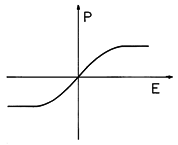Dipole formation, or orientation of dipolar particles, usually depends on the local field in which the particles are situated. This local microscopic field is not necessarily equal to the macroscopic E field. Yet certain relationships between the macroscopic quantities E and P can be established without a knowledge of the relations between the local microscopic fields and the macroscopic E fields. Usually, these relations, called constitutive laws, originate in experimental observations characteristic of the material being investigated.
First, the permanent polarization model developed in the previous section is one constitutive law. In such a medium, P(r) is prescribed independent of E.
There are media, and these are much more common, in which the polarization depends on E. Consider an isotropic medium, which, in the absence of an electric field has no preferred orientation. Amorphous media such as glass are isotropic. Crystalline media, made up of randomly oriented microscopic crystals, also behave as isotropic media on a macroscopic scale. If we assume that the polarization P in an isotropic medium depends on the instantaneous field and not on its past history, then P is a function of E

where P and E are parallel to each other. Indeed, if P were not parallel to E, then a preferred direction different from the direction of E would need to exist in the medium, which contradicts the assumption of isotropy. A possible relation between the magnitudes of E and P is shown in Fig. 6.4.1 and represents an "electrically nonlinear" medium for which P "saturates" for large values of E.

If the medium is electrically linear, in addition to being isotropic, then a linear relationship exists between E and P

where  e is the dielectric susceptibility. Typical values
are given
in Table 6.4.1. All isotropic media behave as linear media and obey
(2) if the applied E field is sufficiently small. As long as
E is small enough, any continuous function P(E ) can
be expanded in a Taylor series of E and broken off with the
first term in E. (An isotropic medium cannot have a term in
the Taylor expansion independent of E.)
e is the dielectric susceptibility. Typical values
are given
in Table 6.4.1. All isotropic media behave as linear media and obey
(2) if the applied E field is sufficiently small. As long as
E is small enough, any continuous function P(E ) can
be expanded in a Taylor series of E and broken off with the
first term in E. (An isotropic medium cannot have a term in
the Taylor expansion independent of E.)
For a linear isotropic material, where (2) is obeyed, it follows that D and E are related by

where

is the permittivity or dielectric constant.
The permittivity normalized to  o , (1 +
o , (1 +  e ), is the
relative dielectric constant.
e ), is the
relative dielectric constant.
In our discussion, it has been assumed that the state of polarization depends only on the instantaneous electric field intensity. There are materials in which the polarization depends not only on the current electric field intensity but on the sequence of preceding states as well (hysteresis). Because we will find magnetization phenomena analogous in many ways to polarization phenomena, we will defer consideration of hysteretic phenomena to Chap. 9.
Many types of transducers exploit the dependence of polarization on variables other than the electric field. In pyroelectric materials, polarization is a function of temperature. Pyroelectrics are used for optical detectors of high-power infrared radiation. Piezoelectric materials have a polarization which is a function of strain (deformation). Such media are suited to low-power electromechanical energy conversion.
| Gases | |
|---|---|
 e e |
|
| Air | |
| 0oC | 0.00059 |
| 40 atmosphere | 0.0218 |
| 80 atmosphere | 0.0439 |
| Carbon dioxide, 0oC | 0.000985 |
| Hydrogen, 0oC | 0.000264 |
| Water Vapor, 145oC | 0.00705 |
| Liquids | |
 e e |
|
| Acetone, 0oC | 25.6 |
| Air, -191oC | 0.43 |
| Alcohol | |
| ethyl | 24.8 |
| methyl | 30.2 |
| Benzene | 1.29 |
| Glycerine, 15oC | 55.2 |
| Oils | |
| castor | 3.67 |
| corn | 2.1 |
| Water, distilled | 79.1 |
| Solids | |
 e e |
|
| Diamond | 15.5 |
| Glass | |
| flint, density 4.5 | 8.90 |
| flint, density 2.87 | 5.61 |
| Mica | 4.6-5.0 |
| Paper (cable insulation) | 1.0-1.5 |
| Paraffin | 1.1 |
| Porcelain | 4.7 |
| Quartz | |
| 1 to axis | 3.69 |
| 11 to axis | 4.06 |

